Sweat, fear and mad dogs in the most paranoid corner of America

Soaked through from the soggy tail end of Hurricane Michael, I leant my touring bike and panniers against the “big” but certainly not “beautiful” 21-foot high border wall dissecting the cities of Brownsville, Texas and Matamoros, Tamaulipas. It was only 9am, but already the temperature had soared to well over 30 degrees centigrade – the fencing, meanwhile, felt cold and hostile against my sweaty palms. I rapped my knuckles against its dense surface to create a solid, low-pitched clunk, before breathing in the rusty steel. This was the structure I’d heard so much about on TV news bulletins, in newspapers and radio broadcasts, in the flesh.
Through the tight metal mesh I could see the Rio Grande, meandering through a lush no man’s land, as a wave of people walked across a caged footbridge. Souped-up pickups revved their engines as they passed through southbound passport controls, while northbound passengers exchanged pesos for dollars in shady “cambios” festooned in gaudy neon. Brownsville felt like a beaten-up backwater – a weathered, stifling city, stuck in a state of edgy transience. It certainly didn’t resemble the United States I thought I knew, and after just half an hour of people watching and rehydrating I was relieved to be hitting the open road.
I’d been mulling over the idea to cycle a section of the US-Mexico border for a couple of years, following a 4,000-mile ride across the northern US in 2016, as part of a 15,000-mile land and sea adventure from China to London, including ghastly crossings of the Pacific and Atlantic oceans. The generosity, hospitality and sense of freedom I’d experienced on that ride had left me feeling like I had unfinished business in North America, coupled with a journalistic desire to find out what this geopolitical flashpoint looked and felt like for myself. But as I turned onto U.S Highway 281, running adjacent to the border fence, I already had a gut feeling that this ill-conceived endeavour would end up filed in the “seemed much simpler on paper” category of my misadventures around the world.
Before you scream, “Well, obviously!” at the screen, I knew, of course, that this region was going to feel dodgy, but I couldn’t have foreseen the feeling of paranoia I sensed there, in contrast to what I’d found up north. In states like Montana, Idaho and Washington it had felt like I could knock on front doors to ask for water, strike up conversations with police officers in gas stations and camp (responsibly) on public land. In southern Texas none of that seemed possible.
Texan newspapers and TV news shows appear to be dining out on a narrative of fear – almost every story, it seemed, was about either a terrifying shooting or the looming threat “across the border”. Flicking intermittently to Mexican channels, as you can do in borderland motels, is a fascinating experience. On the English language news programmes there appears to be an impending sense of conflict and doom, meanwhile the Hispanic-aimed content is of a significantly more human interest feel – slower paced, with lingering close-ups of women and children, telling stories of social inequality, unemployment and housing shortages. None of this happens by chance.
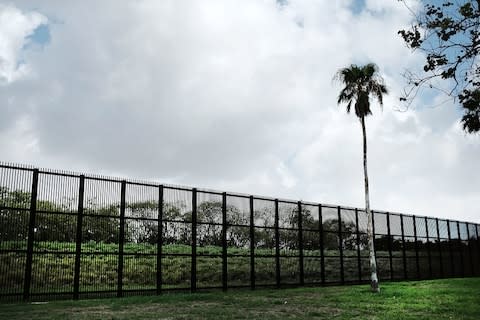
I’ve been lucky, or indeed silly enough, to cycle large distances around the world – across Europe, South Africa, the US and the length of Scandinavia, and I’ve become hooked on the feeling of freedom it provides me. Not so on this ride – there were Border Patrol vehicles, seemingly, everywhere. On one hand this gave me a sense of safety in a region that’s meant to be unsafe, but on the other it felt like I was being watched and monitored constantly. And I probably was – there’s conspicuous surveillance equipment everywhere. Torpedo-shaped blimps have been deployed above the border wall and helicopters buzz up and down alongside the occasional drone. I’ve been to dozens of dubious border regions all over the world, but none that have ever seemed so cagey and devoid of character.
Texas is, and felt, overwhelmingly enormous. It’s 10 per cent larger than France, while Germany, Belgium and the UK could fit into it comfortably. The roads are mind-numbingly long, almost entirely flat, and despite experiencing the very subtle, sadistic thrill of putting my body through hell beside a maligned international border, cycling there was really rather... dull. Moreover, unlike when I traversed the northern states in 2016, so many people appeared to be living on expansive plots of land behind gates and fences that I really didn’t fancy wandering into.

Quite possibly because every mutt in Texas had it in for me – and on nearly a dozen occasions I faced ferocious guard dogs snapping at my sunburnt calves and ankles – often giving chase for a thousand feet or more. On one particularly petrifying occasion a ferocious mongrel roared across a four-lane highway towards me, only to be clattered by a 4X4, sending it cartwheeling like a stuffed toy across the tarmac. I was convinced it must have been killed instantly, but miraculously it got up and limped back to its porch.
An incessant six-foot high barbed wire fence runs beside the majority of the old military highway on the southern frontier with Mexico, while “KEEP OUT” and “NO TRESSPASSING” signs fill in the rare gaps between. Many homes back directly on to the towering border fence, but in other sections vast ranches sprawl southward, towards a never-ending horizon of scrub and spinifex. I found there to be a strange, melancholic sense of nothingness, punctuated by the occasional historical marker detailing battles and skirmishes between the United States and Mexico during the 19th century. South-facing cast iron cannons have been set into concrete alongside the graves of American army officers. “The spot where American blood was shed on American soil,” read one such sun-weathered and graffiti-covered epitaph.
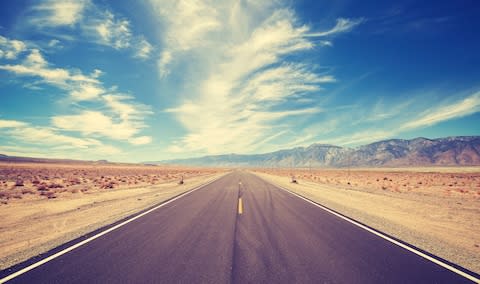
“We call this the militarised zone,” said Marianna Wright, executive director of the 100-acre National Butterfly Centre – a sanctuary for wildlife running adjacent to the Rio Grande that’s facing a potentially devastating dissection from the encroaching border wall.
“Some butterflies are genetically programmed to fly around their host plants,” she told me, as we pondered the greenish-brown river. “So if their host plant is a tree, they’re going to fly as high as that tree. Those butterflies are not going to go over a 36-foot wall for any reason.” Border Patrol has gained access to her land and she suspects bulldozers will make light work of this precious ecosystem in the near future. Thickets of dense undergrowth may well be good for wildlife, but they also make it harder for authorities to track down and apprehend illegal immigrants.
Growing up here in the 1970s and 80s, Marianna used to fish and swim beside the “beach bars” and RV parks on the river’s northern banks. These are now all but obsolete – caught in a thin no-go sliver of flood-prone land that may soon be south of the United States border fence. On the Mexico side, however, she told me that things remain distinctly different. “They’re still enjoying the river. You go up here and there’s a beautiful club/bar where the kids are out riding their jet skis... there are parks and soccer fields all backing onto the Rio Grande and it used to be that way here, too. This is where we hung out every weekend! And all of that business has been killed by the false narrative that has been told about this being a dangerous area. People screaming ‘build the wall’ have never been here.”
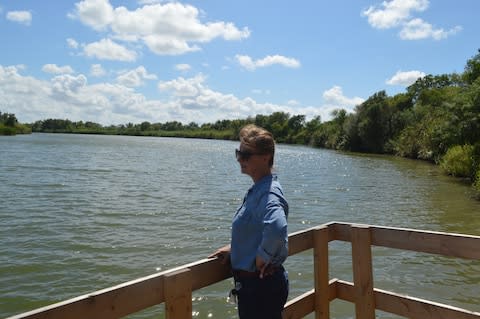
The lush scene was undeniably picturesque, but from what I’d experienced, the reality was probably somewhere in the middle. Marianna is clearly emotionally invested in the plight of the animal species living beside the Rio Grande, which desperately need a defender and many of which aren’t found anywhere else on the planet. However the high concentration of Border Patrol, surveillance installations and stories of drug-running cartels didn’t exactly make it an attractive spot for sunbathing with a mojito. I doubt that will change in my lifetime.
Back on the road, my closest encounters with the native wildlife came in the shape of road kill in varying stages of decomposition – most of which I could smell long before I caught sight of. I cycled over a paper-flat rattlesnake in excess of six feet long and an upturned, armour-plated armadillo with a bloodied, pig-like nose. Turkey vultures with five-foot wide wingspans soared and circled overhead, occasionally dive-bombing on the road in front of me. Maybe I seemed like smaller prey from above, or perhaps they could sense my fading, weary disposition.
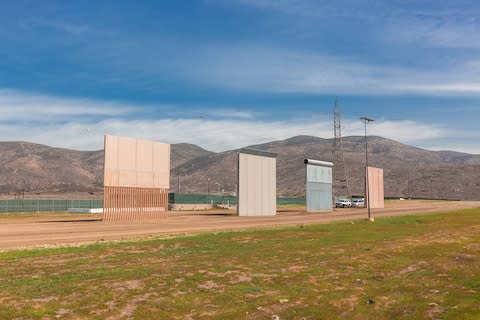
As I ventured further west, the gaps between small towns grew further and further, making it significantly harder to find and carry enough water. On the afternoon I reached the small town of Zapata – at the end of an 80-mile ride through exposed semi-desert, the temperatures were forecast to hit 39 degrees centigrade. I have no doubt I was cycling in heat much nearer 50 degrees on the exposed asphalt. I lost count of how many litres of water I drank that day and it still didn’t feel like enough.
Moving at such a slow pace certainly turns you into a sitting duck, of sorts – and at times I felt vulnerable and isolated. But cycling remains a mode of transport that really allows me to soak a place up, gradually, in a way that whizzing through in an air-conditioned vehicle at 70mph never will. I’ve been lucky to see lots of the world as a journalist, but sometimes the newsgathering process can feel dizzyingly frantic – in-out reporting, lacking the time to fully digest a place before then moving onto the next story.
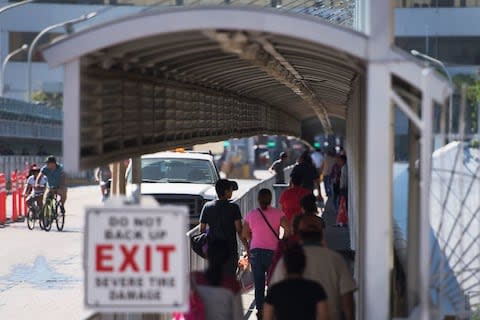
These sorts of trips, in which I simply sit in the saddle for 10-12 hours a day, are the total antitheses to that. And while it might not have been anywhere near as pretty, or as fun, or as exciting as my journey in 2016, I feel like the overall experience of spending quality time beside such a talked about border has brought this region to life for me in a way no newspaper article or TV news report ever could. That, for me, remains at the crux of why I travel – to place real life memories in my brain, rather than simply taking someone else’s word for it. And with that in mind, my 300-mile solo ride in southern Texas came to a sweaty end in the border town of Laredo, feeling exhausted but privileged to have seen this place with my own eyes – plus, thankfully, with my ankles still intact.